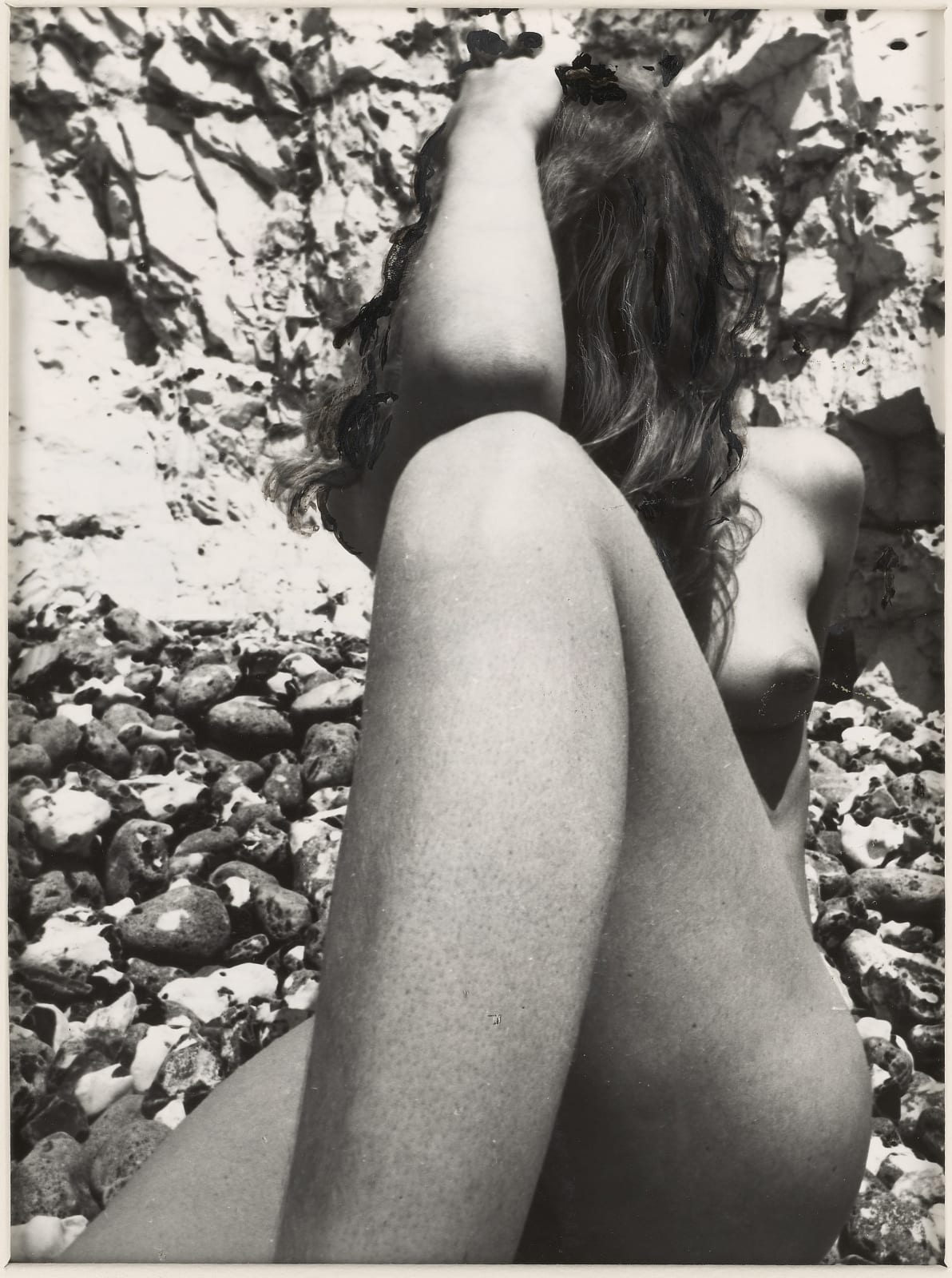Bill Brandt 1904-1983
East Sussex Coast, 1978
vintage gelatin sliver print, with hand re-working by the artist
9 1/8 x 7 3/4 inches
23 x 19.7 cm
23 x 19.7 cm
Bill Brandt photographed his first nudes in the 1930s, but this aspect of his work really took off in 1945, after he acquired a police issue Kodak camera, whose 110...
Bill Brandt photographed his first nudes in the 1930s, but this aspect of his work really took off in 1945, after he acquired a police issue Kodak camera, whose 110 degree fixed lens rendered everything more than 4 feet away in sharp focus. It was to transform his vision:
‘Instead of photographing what I saw, I photographed what the camera was seeing. I interfered very little, and the lens produced anatomical images and shapes which my eyes had never seen’ 1
Brandt embarked upon an unparalleled series of expressive nudes, photographed in empty Victorian interiors, their limbs radically distorted and foreshortened and the perspective of the room opened out. This experimental work had a mysterious atmosphere, informed by the paintings of Balthus, Picasso and Matisse and the photographs of Man Ray, Weston and Kertész, but which was, at the same time, highly distinctive and peculiarly English, suggesting the realism of the peep show and Sickert’s Camden Town.
The present work is from a series of nudes made on Newhaven Beach, East Sussex between 1977 and 1979, which reprised a subject Brandt had first explored between 1953 and 1960, latterly abandoning his bulky Kodak camera for a more manoeuvrable Hasselblad. The position of the model here - where a raised leg dominates the composition and an arm covers the face - is prefigured in works such as Perspective of Nudes no.30, London, 1953 and Nude, Campden Hill, London, 1958. In these earlier, indoor images, Brandt could carefully control the scene, using portable lights to cast deep shadows, which in turn bleached out the model’s skin, creating an image with ostensibly two tonal values. Here, the limitless available light offers an exposing level of detail, which allows us to see every pore, crease and hair on the model’s skin. The equally detailed rendering of stones and cliff produces a multi-toned, highly textured image in which the figure is integrated within, and equal to, the landscape.
The low angle from which Brandt shot these images transforms his models into expansive, sculptural entities, set against a backdrop of nature. They were undoubtedly influenced by the work, and photography, of Henry Moore, whom Brandt knew well and had photographed more than any other portrait photographer. Just as Brandt would choreograph his nude and even documentary photographs, he was equally creative in the darkroom. He would crop into the image, make composites from more than one negative and manipulate tone using darkroom techniques such as dodging and burning and retouching, (seen here), until the print reflected his own, exacting vision.
1 The photographer in ‘A Statement on Photography’ http://www.billbrandt.com/bill-brandt-a-statement/, first published in ‘Camera’, London, 1948
‘Instead of photographing what I saw, I photographed what the camera was seeing. I interfered very little, and the lens produced anatomical images and shapes which my eyes had never seen’ 1
Brandt embarked upon an unparalleled series of expressive nudes, photographed in empty Victorian interiors, their limbs radically distorted and foreshortened and the perspective of the room opened out. This experimental work had a mysterious atmosphere, informed by the paintings of Balthus, Picasso and Matisse and the photographs of Man Ray, Weston and Kertész, but which was, at the same time, highly distinctive and peculiarly English, suggesting the realism of the peep show and Sickert’s Camden Town.
The present work is from a series of nudes made on Newhaven Beach, East Sussex between 1977 and 1979, which reprised a subject Brandt had first explored between 1953 and 1960, latterly abandoning his bulky Kodak camera for a more manoeuvrable Hasselblad. The position of the model here - where a raised leg dominates the composition and an arm covers the face - is prefigured in works such as Perspective of Nudes no.30, London, 1953 and Nude, Campden Hill, London, 1958. In these earlier, indoor images, Brandt could carefully control the scene, using portable lights to cast deep shadows, which in turn bleached out the model’s skin, creating an image with ostensibly two tonal values. Here, the limitless available light offers an exposing level of detail, which allows us to see every pore, crease and hair on the model’s skin. The equally detailed rendering of stones and cliff produces a multi-toned, highly textured image in which the figure is integrated within, and equal to, the landscape.
The low angle from which Brandt shot these images transforms his models into expansive, sculptural entities, set against a backdrop of nature. They were undoubtedly influenced by the work, and photography, of Henry Moore, whom Brandt knew well and had photographed more than any other portrait photographer. Just as Brandt would choreograph his nude and even documentary photographs, he was equally creative in the darkroom. He would crop into the image, make composites from more than one negative and manipulate tone using darkroom techniques such as dodging and burning and retouching, (seen here), until the print reflected his own, exacting vision.
1 The photographer in ‘A Statement on Photography’ http://www.billbrandt.com/bill-brandt-a-statement/, first published in ‘Camera’, London, 1948
Provenance
The Art Institute of Chicago
Literature
Michael Hiley (intro.), Bill Brandt Nudes 1945-1980, Photographic Monographs: 8, Gordon Fraser, London, 1980, pl 95, illusLawrence Durrell, Mark Haworth-Booth, Brandt Nudes, A New Perspective, Thames and Hudson, London, 2012, illus p163
Join our mailing list
* denotes required fields
We will process the personal data you have supplied to communicate with you in accordance with our Privacy Policy. You can unsubscribe or change your preferences at any time by clicking the link in our emails.
